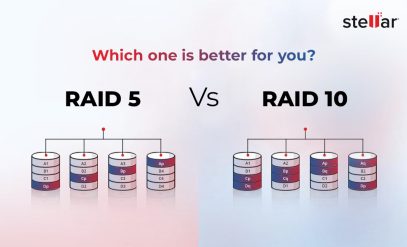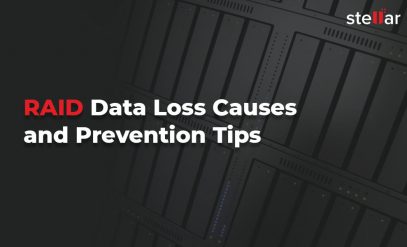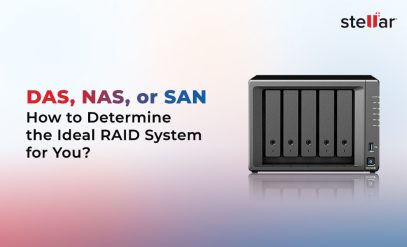|
Summary: RAID servers, in general, are reliable and stable in managing and accessing data. But like most technologies, RAID servers can also break down or crash. The consequences of a breakdown can be disarming, leading to the loss of files and information. This blog post explains the significance of RAID servers, what happens if the server crashes, and how to protect your important files in such a situation. and how to recover data from Raid 5. In the case of a RAID server crash, the best option is to seek the help of professional RAID data recovery services such as Stellar Data Recovery Services. |
|---|
Table of Content
- Causes of RAID Data Loss or RAID Failure
- Tips to Prevent RAID Data Loss
- Types of RAID Levels
- How to Recover Data from RAID Server?
- What to do for RAID Data Recovery?
Redundant Array of Independent Disks, popularly known as RAID, is a configuration of multiple disk drives into one or more logical units for data redundancy, performance improvement, or both. Invented in the late 1980s, RAID servers continue to be used extensively even today. This Data Storage Visualization Technology is used in enterprises and businesses for three key reasons.
- Reap redundancy data
- Improves performance
- Combining components of multiple physical disk drives into one logical unit
Depending upon performance and required redundancy level, RAID servers are further categorized into RAID levels. These help in preventing data loss in case of a drive failure. In a scenario, when one drive fails, you can count on other drives to access the data. With this, in addition to performance, storage capacity, reliability, and data availability also improve. RAID may be the most reliable option to secure data, but it is not completely immune to failure.
Causes of RAID Data Loss or RAID Failure
The common reasons for RAID failure include failure of the RAID controller, missing RAID partitions, multiple disk failures, or server crashes. But there are multiple other possibilities that could lead to the failure of the RAID server. It can broadly be divided into physical causes, failure due to human error, and logical failure.
| Physical Failure | Human Error | Logical Failure |
| Multiple drives failure | Data deletion | Files and folders damage |
| RAM failure | Reformatting of drives and arrays | Trojan, virus, or worm |
| RAID Controller Card | Accidental initialization | Registry configuration |
| Electrical & physical drive failure | Incorrect replacement of drives | Damage of directory structure |
| Physical RAID failure | RAID configuration issue | |
| Natural disasters | Corrupt operating system | |
| Failed Backplane and Motherboard | ||
| Bad sectors |
Tips to Prevent RAID Data Loss
If you have even a slight doubt that the RAID server is crashing, it’s imperative to take precautionary measures to protect your data from further damage. Here are some RAID Data Loss Prevention Tips:
- Say no to overwriting
- Avoid faulty installations
- Say no to RAID partition reconfiguration
- Ensure to label drives in the array at their positions
- Always keep powerful antivirus software handy
- Make sure there is no power outage or interrupted power supply
- Avoid formatting or deleting drive partitions/data
- Don’t use Repair Utility to repair the damaged drive on a partition that is inaccessible
- Don’t use defragmented utility before examining the drive’s health
- Avoid RAID rebuilding in cases when the drives are not healthy
- Say no to the RAID process of rebuilding in scenarios where multiple drives failed at one go
- Keep your RAID system protected against natural disasters such as fire, flood, etc.
Types of RAID Levels
RAID is available in different schemes or RAID levels. The most common levels are RAID 0, 1, 5, 6, and 10. RAID 0, 1, and 5 work on both hard disk drives (HDD) and solid-state drives (SSD). Thus, it is important to understand the schemes or levels they are available in and their functions.
- RAID 0: Striping — With a requirement of a minimum of two disks, RAID 0 splits files and strips the data across two disks (or more). It treats the striped disks as a single partition. Multiple hard drives read and write parts of the same file at the same time, leading to faster output.
- RAID 1: Disk Mirroring — Two disks work simultaneously in RAID 1, reading and writing the exact same data to each disk. If a mirrored disk fails, the entire file exists on the functioning disk.
- RAID 5: Striping With Parity — It distributes striping and parity at the block level. RAID 5 calculates its values to create a parity block, which the system uses to recover striped data from a failed drive.
- RAID 6: Striping With Double Parity — It functions in the same way as RAID 5, but with a minimum of four disks. It allows the system to store an additional parity block on each disk.
- RAID 10: Striping and Mirroring — This too requires a minimum of four disks in the array. It stripes across disks for higher performance and mirrors for redundancy. In a four-drive array, the system stripes data to two disks, the other two mirror the striped disks, each one storing half the data.
Additional Reading: What are the RAID Levels 0, 1, 5, 6, and 10?
How to Recover Data from RAID Server?
Here are some ways to recover data from the RAID server, based on the cause and data loss situation.
Case 1: There is one disk failure and the RAID server is running in Degraded Mode. Now, you need to recover a bit of critical data.
In this situation, you can recover data fully without sharing the RAID server.
What to Do?
- Copy data immediately without rebuilding the data
Note: If any other disk fails, the complete RAID server will fail.
Case 2: There is one disk failure and the RAID server enters into Degraded Mode. Now, you need to recover everything, including applications to boot up the operating system.
It is a situation where the RAID server is either Data Server or an Application. Thus, recovering only data is not sufficient.
What to Do?
- Attempt to rebuild degraded RAID volume
Note: Make sure to back up the disk image before rebuilding.
Case 3: RAID Disk Volume Loss.
Disk Volume Loss can be a result of RAID configuration settings loss, multiple disks failure, power surges, system crashes, or other unknown reasons.
What to do for RAID Data Recovery?
- Seek Professional Data Recovery Assistance
Why you should count on a Professional Data Recovery Service to Recover Data from Crashed RAID Server?
A professional data recovery services provider like Stellar has years of experience in data recovery. Some main reasons to seek help from professional data recovery services providers include:
- Specialized equipment
- Specialized environment
- Latest technology deployment
- Trusted and dedicated professionals
- Comprehensive knowledge about domains such as Hex, Offset, MFT Mount points, and drive structure
The data Recovery marketplace has a plethora of data recovery service providers. One such reliable and trusted data recovery services provider is Stellar. It is an ISO 27001:2013 and ISMS-certified company, with more than 25 years of experience in data recovery. It has a Class 100 Clean Room Lab, an experienced research and development team, biometric-controlled security, and cutting-edge technology. This makes Stellar one of the best data recovery service providers available in the country.
Read out the Case Study for RAID Server Recovery.
Conclusion
RAID servers, widely used across businesses, enhance performance and security with their storage and computing capabilities. These servers come in different schemes and levels depending on the users’ requirements. Each RAID level has some sort of protection mechanism to secure your data. But certain logical, human, or software errors can lead to a system crash, putting the data at risk of loss or making it inaccessible. In such a scenario, the best option is to seek the help of professional RAID Data Recovery service providers, like Stellar Data Recovery.








